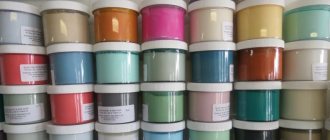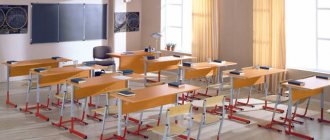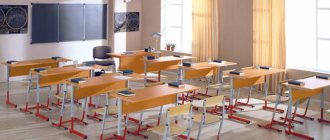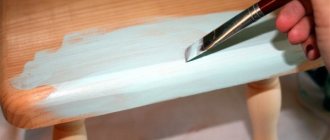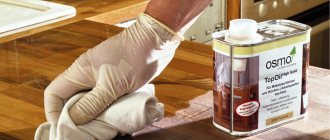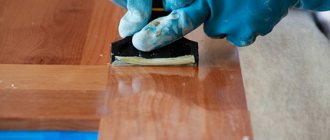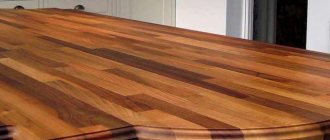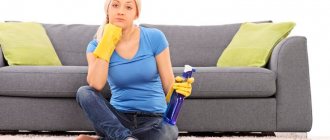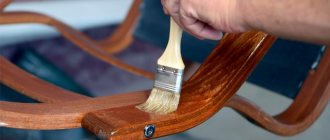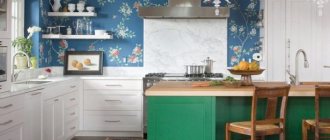When might odorless wood furniture paint be needed? When there is a desire to give new life to old cabinets, chairs, tables and give a long-boring interior a little originality and charm. Or maybe a successfully purchased uncoated chest of drawers triggers a flow of creative energy and makes you think through possible options for its transformation in your head. In both cases, you can’t do without paint for wood, and if you have to work directly in an apartment or house, then you need a special paint - odorless and drying very quickly, so as not to cause inconvenience to yourself or your loved ones.
How to choose paint for furniture
It is necessary to take into account the composition of the surface to be coated, the service life and decorative qualities of the item. This will help you avoid mistakes and make the right choice of material.
For children's furniture, you should select acrylic and water-dispersion paints, since from an environmental point of view they are the safest for human health because they do not contain harmful components.
The same goes for kitchen items. The coating will not allow grease and other contaminants to be absorbed into the surface, which will greatly facilitate maintenance.
Protecting the painted surface
In cases where furniture is actively exposed to water or dirt (for example, kitchen facades or hallway furniture), it becomes advisable to apply varnish to the painted surface. It should also be chosen with acrylic in its composition, just like paint. Varnishes can be either glossy or matte. It is applied with a brush or roller to completely dry paint.
So, repainting chipboard furniture with your own hands will not be difficult, especially if you first carefully study all the nuances. After all the work, you can really get furniture that will become the highlight of the interior and bring individuality to the design of any home. Thus, with the help of paint you can transform an old kitchen, dining area, chests of drawers and bedside tables, wardrobes and bedroom sets.
Despite the apparent complexity, the work does not take much time, if you do not take into account the drying time of each layer, and allows you to get truly exclusive furniture while saving money.
Acrylic based paint
Acrylic paints dry quickly, are odorless, non-toxic and fireproof. Due to the presence of such positive characteristics, acrylic-based paints are appreciated by consumers, which makes them quite popular.
When using this material, there is no need to prime the surface; this indicates good adhesion of the paint to the base.
- The paint is white, and this makes it possible to experiment with shades.
- If you choose the right color pigment, you can add a little creativity, diluting the monotony of repair work.
Types of chipboard
Chipboard has several varieties. First of all, it is divided by area of application:
- Construction boards. Used for external and internal work. They are durable, moisture-resistant, protected from the development of fungus and bacteria. To obtain such slabs, special components are added to the chips. This material can be either polished or unpolished.
- Standard slabs. Suitable for indoor use, they are not treated to enhance their protective properties. Furniture is made from such chipboard.
- Special plates. Such material is required to satisfy all additional customer wishes. They can be fire-resistant and have enhanced protective properties.
Each type of work involves choosing a certain type of chipboard.
Latex based paints
Previously, oil paints were used to coat wooden objects. But due to the strong, persistent odor, it is better to avoid them in favor of a safe latex emulsion.
This type of paint penetrates deeply into the surface, forming a protective layer from moisture, and therefore from further destruction of the object.
But there is one drawback. The product is sensitive to temperature changes, so items and furniture coated with it should not be left outdoors.
Water-soluble paints for furniture
Water-dispersible products are loved by consumers for a number of positive qualities, such as:
- Environmental Safety;
- Dries quickly;
- Durable, damage-resistant coating;
- Water resistance of the coated surface;
- Variety of coatings (matte, glossy);
- Possibility of choosing shades.
Transparent paint for furniture
Today the market offers both transparent and colored products, and they are endowed with the following characteristics:
- Help prevent surface fading and pattern fading.
- They have a transparent composition, this helps not to overlap the wood texture and other original ornaments.
- Helps moisture evaporate freely.
Organic paints
Such funds are a budget option. They form a strong, durable coating and can be used in bathrooms, showers and toilets.
- But such a coating does not allow air to pass through well.
- Therefore, objects painted with it often become covered with bubbles.
- It turns out that the product is not advisable to use on wooden surfaces.
Today, organic enamels are not popular because they have a strong, toxic and persistent odor, which negatively affects human health.
Silicone paint
Made on an acrylic base with the addition of silicone. The paint is resistant to damage and has a water-repellent property.
- It is strong, but at the same time elastic and easily fills all the cracks in the wood.
- The paint allows air to pass through well, which does not lead to the formation of bubbles on the coated surface.
This is a durable, wear-resistant, but expensive material.
Decorative chipboard coating
Decorative coatings are often applied to standard slabs. These include:
- Melamine film and subsequent coating with a layer of varnish. In this way, a laminated material is obtained, which can be identified by looking at the marking: the letter “K” is added to the name.
- Melamine film pasted under high temperature and pressure is a lamination process. The letter "L" is added to the name. This type of coating significantly increases resistance to moisture and improves appearance.
- Veneer is a very thin cut of wood. It is glued to the surface of the slab and coated with varnish. Externally, such slabs differ little from real wood.
When wondering how to repaint chipboard furniture with your own hands, it is important to have knowledge of which types of boards are better: chipboard, laminated chipboard or veneered. The worst option is laminated slabs. The varnish wears off quickly, the design disappears, and furniture made from such material cannot be restored.
Veneered chipboard and laminated chipboard have approximately the same properties in terms of coating strength, but the former is less resistant to moisture and is much more expensive. It is not always wise to use it in rooms with high humidity: kitchens, bathrooms, and so on.
Paint application technology
Before performing work, you should decide which paint is best to coat furniture or objects.
After this, you can proceed to surface treatment, for this:
- The old coating should be removed. You can use car wash; apply it with a brush to the work surface. Particular attention should be paid to the corners. The composition must be left until completely dry, and then the paint must be cleaned off with a spatula.
- A wire brush will help remove any remaining layer, and using sandpaper you can thoroughly sand the surface.
- After treatment, wipe the wood with a damp cloth to completely remove all debris and dust.
- It is necessary to putty all the irregularities protruding on the surface. After this you need to prime the base.
- It’s worth starting work from the sides. The movements must be precise and fast, otherwise streaks may remain. It is more convenient to apply the paint with a roller or a wide brush.
- Each layer needs to dry well for about 40 minutes.
- When applying layers, you need to achieve uniform coverage. Then the work will look high quality.
What is chipboard
Chipboard is a special type of sheet construction and finishing material. The abbreviation comes from the full name: particle board. It consists of sawdust compressed under pressure and at high temperature, combined with special compounds (natural or artificial).
Chipboard is made from residues after wood processing. Use sawdust, small shavings, and so on. Sometimes non-commercial wood or re-grade wood is shredded.
Tips and tricks for painting furniture
In order to apply the composition correctly, you should follow some rules:
- During paint and varnish work, it is important to take care of measures to protect the respiratory tract from the negative effects of harmful toxic substances.
- To remove old coating, it is better to use removers with a gel-like consistency. They will not drain from the surface.
- In order to clean off the old layer, it is better to use a wide spatula.
- Acrylic paints work well with a brush, and a velor roller can be used to paint furniture.
By choosing a good quality paint that matches the texture of the surface being treated, you can do the paint work yourself just as well as an experienced painter.
At the same time, transform old furniture or other items that are expensive, giving them a second life.
Removing the top laminated layer
To protect the painted surface from swelling and cracking, the top layer should be removed from furniture elements. To do this, use sandpaper. Firstly, you will need coarse-grained sandpaper for cleaning at the main stage, and only then fine-grained sandpaper to consolidate the result and create a surface for painting kitchen furniture made of chipboard or bedside tables. This action creates roughness and the paint will stick.
During work, personal respiratory protection should be used to prevent dust from entering the lungs.
